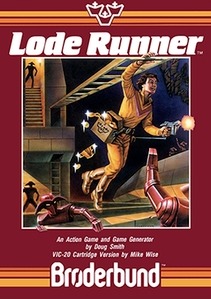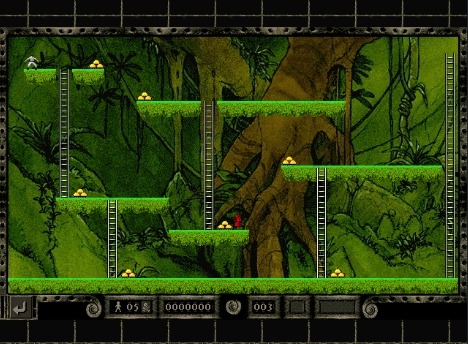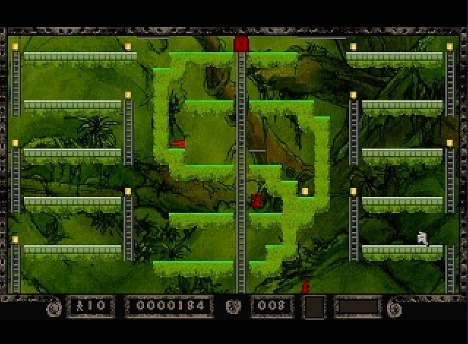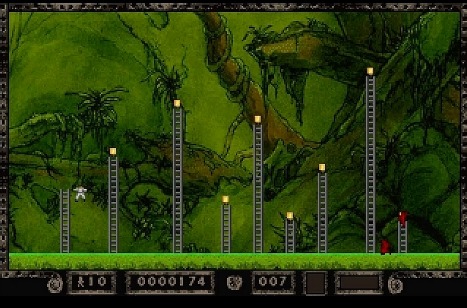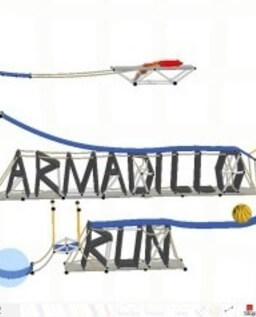Notably, the player can dig a hole only to the sides, and not directly underneath himself. This introduces an important strategy for when digging a hole x blocks deep, the player must first dig a gap at least x wide to be able to dig through it, as the number of spaces will shrink with each layer, and the player needs at least one free adjacent space to be able to dig. However, exceptions to this rule arise when the player digs from the position of standing on a ladder, or hanging from a hand-to-hand bar, which allows the player to repeatedly dig and descend one row. This kind of digging is involved in solving many of the levels.
The player starts with five lives; each level completion awards an extra life. Should a guard catch the player, one life is subtracted, and the current level restarts. The player's character can fall from arbitrary heights without any injury but cannot jump, and players can trap themselves in pits from which the only escape is to abort the level, costing a life, and begin again.
Enemy A.I.
The guards do not simply home in on the player by always taking the shortest path, but also move in counter-intuitive ways according to a strange algorithm. This is a key factor in game logic, especially in the advanced levels, where exploiting the behavior of the guards is essential toward attaining the solution. Sometimes, when the player and a guard are on the same ladder, for instance, the guard will move away from the player. In general, depending on the exact positioning relative to Lode Runner, the guards sometimes appear to be repelled. The behavior is far from random, however. A big part of mastering the game involves developing the intuition to predict the movement of the guards.
Permitted contact
The player may come into contact with a guard directly from above, with the stick figure's feet touching the guard's head. This is what enables the player to walk over guards who are temporarily stuck in a hole that has been dug. It is also possible to make this contact while both the guard and the player are in free fall, since the player not only runs faster than the guards, but also falls faster; moreover, it is possible to survive the feet-to-head contact while a guard is standing on a platform and begins to move. Both forms of contact are necessary to solve some levels. Sometimes it is necessary to liberate a trapped guard by digging while standing on his head, but then moving rapidly in the opposite direction when the guard begins marching to freedom. In a few levels, it is necessary to use a falling guard as a bridge to reach an otherwise unreachable area. One subtlety is that if a down movement is initiated while standing on a guard's head, or briefly touching the guard's head during free fall, the consequences are fatal.
Trapping and using guards
In some levels, guards can be deliberately trapped in various ways. For instance, they can be lured into entering a part of the level from which there is no escape. In some situations, the player can liberate trapped guards by digging them out. In some levels, to collect some gold pieces, the player must exploit the guards into collecting gold pieces, because they are positioned such that whichever figure collects them will become trapped. When the guard collects the piece and becomes trapped, the player can release the guard and then later steal the gold when the guard drops it or falls into a hole.
In some levels, there are gold pieces which can be collected only by killing guards by trapping them in dug holes which close up. Deceased guards come back to life from locations near the top of the screen, which may allow them to reach parts of the level that cannot be reached by the player.
Traversal orders
Some levels require careful ordering of traversal, because they are divided into zones connected by passages which are impossible to traverse in the reverse direction. If a gold piece remains in an unreachable zone, the player may have to abort the level to start again, losing a life, unless there is a way to coax a guard into bringing the gold.
Timing
Some of the game's puzzles in the advanced levels are time-sensitive. The player must dig in order to penetrate the interior of some cavern to collect gold, and quickly return the same way before the digging repairs itself, enclosing Lode Runner in that cavern with no means of escape.
Some puzzles require deliberate timing among the digging actions because Lode Runner must run over previously dug-out tiles that have just repaired themselves, while having enough time to pass through ones which have not yet repaired.
